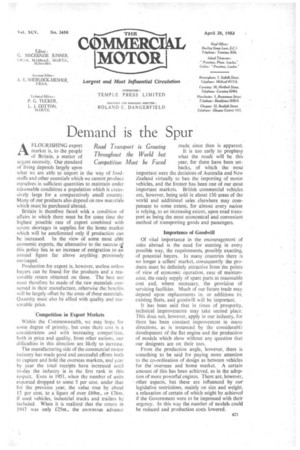Demand is the Spur
Page 59

If you've noticed an error in this article please click here to report it so we can fix it.
Road Transport Throughout the Competition Mus
-A FLOURISHING export market is, to the people of Britain, a matter of urgent necessity. Our standard of living depends largely upon what we are able to import in the way of foodstuffs and other essentials which we cannot produce Ourselves in sufficient quantities to maintain under reasonable conditions a -population which is excessively 'large for a comparatively small country. Many of our products also depend on raw maierials which must be purchased abroad.
• Britain Is therefore faced with •a condition of • affairs in Which there must be for some time the highest possible rate of export combined with severe shortages in supplies for the home market which will be ameliorated ordy if production can be increased. In the View of Some most able economic experts, the alternative to the success 91 this policy liesin an increase of emigration to an annual figure far above anything previously envisaged.
Production for export is, however, useless unless buyers can be found for the products and a reasonable return obtained on these. The best use must therefore be made of the raw materials con.sumed in their manufacture, otherwise the benefits will be largely offset by the costs Of these materials. Quantity must also be allied with quality and reasonable price.
Road Transport Throughout the Competition Mus
Competition in Export Markets Within the Commonwealth, we may hope for some degree of priority, but even there cost is a consideration and with increasing comp-et.ticm, both in price and quality, from other nations, our difficulties in this direction are likely to increase.
The manufacturing side of the commercial motor industry has made good and successful efforts both to capture and hold the overseas markets, and year by year the total receipts have increased until to-day the industry is in the first rank in this respect. Even in 1951, when the number of units exported dropped to some 5 per cent. under that for the previous year, the value rose by about 12 per cent. to,a figure of over £69m., or £76m. if used vehicles, industrial trucksand trailers be included. When it is realized that the return in 1947 was only E25m., the enormous advance
made since then is apparent.
It is too early to prophesy what the result will he this year, for there have been setbacks, of which the most important were the decisions of Australia and New Zealand virtually to ban the importing of motor vehicles, and the former has been one of our most important markets. British commercial vehicles are, however, being sold in about 150 areas of the world and additional sales elsewhere may compensate to some extent, for almost every nation is relying, to an increasing extent, upon road transport as being the most economical and convenient method of transporting goods and passengers.
is Growing World but t be Faced
Importance of Goodwill Of vital importance in the encouragement of sales abroad is the need for meeting in every possible way, the requirements, possibly exacting, of potential bilyers. In many countries there is no longer a sellers' market, consequently the products must be definitely attractive from the points of view of economic operation, ease of maintenance, the ready supply of spare parts at reasonable cost and, where neeessary, the provision of servicing facilities.. Much of our future trade may depend upon replacements in, or additions to, existing fleets, and goodwill will be important.
It has been said that in times of prosperity, technical improvements may take second place. This does not, however, apply in our industry, for there has been constant improvement in many directions, as is instanced by the considerable development of the flat engine and the production of models which show without any question that our designers are on their toes.
From the production angle, however, there is something to be said for paying more attention to the co-ordination of design as between vehicles for the' overseas and home market. A certain amount of this has been achieved, as in the adoption of more powerful engines. There are, however, other aspects, but these are influenced by our legislative restrictions, mainly on size and weight, a relaxation of certain of which might be achieved if the Government were to be impressed with their urgency. • In this way the number of models could be reduced and production costs lowered.




























































































































































































































